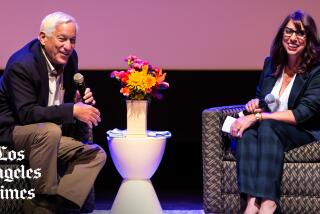Stephen Hawking memoir “My Brief History” out Tuesday (PHOTOS)
- Share via
For many science fans, watching Stephen Hawking give a speech — perched on a stage, nearly motionless in his wheelchair, holding forth in the computerized voice that has become his trademark — is a rare treat. At Caltech, where the physicist comes for regular extended visits, people line up for hours for a chance to get a ticket. Those who can’t get admission to the lecture hall watch on screens set up outdoors, craning their necks for a glimpse of their hero.
LA Times: Stephen Hawking speaks to Cedars-Sinai staff in 2013
Now readers everywhere can share a piece of that experience, as Hawking’s new memoir — which expands on his popular talks — goes on sale Tuesday.
“My Brief History” (a play on the title of his bestseller, “A Brief History of Time”) is a breezy, 126-page volume, heavy on anecdotes and photos, peppered with doses of hard science and good humor.
It’s a quick read, with 13 chapters organized more or less chronologically. Hawking writes about his childhood, his studies at Oxford and Cambridge, and his sometimes-unorthodox personal life. He describes ups and downs with his two former wives, Jane and Elaine, in a chapter called “Marriage,” which emphasizes the challenges Hawking’s deteriorating health posed for the women he married.
“Jane became more depressed,” he writes in one memorable passage:
She was worried that I was going to die soon and wanted someone who would give her and the children support and marry her when I was gone. She found Jonathan Jones, a musician and organist at the local church, and gave him a room in our apartment. I would have objected, but I too was expecting an early death and felt I needed someone to support the children after I was gone.
Hawking’s illness — he has a form of amyotrophic lateral sclerosis, a degenerative nerve disease that has left him wheelchair-bound for decades — is ever-present in the book, though never the dominating focus. By describing the progression of his disease throughout the narrative, he gives a sense of how slowly his symptoms came on.
As a student at Oxford, Hawking writes, he became “increasingly clumsy”; In 1963, soon after moving to Cambridge, he got his diagnosis. By 1965, shortly after his wedding, he writes that he began finding it harder to walk. In 1974, during a stint at Caltech, he began using an electric wheelchair. By the mid-1980s he had turned to computer programs to help him write and speak. (Today, Hawking wiggles his cheek to move a cursor across a screen and pick out words. He can write about three per minute; according to his publisher, Bantam Books, Hawking took two years to expand the text of his lectures to complete “My Brief History.”)
The science in Hawking’s book is a slower read than the autobiographical material and includes chapters on black holes and the Big Bang, as well an extended section on time travel (read the book to find out if he thinks such a thing is possible.) Hawking also describes how he came to write “A Brief History of Time,” why he’s flattered it has been compared to “Zen and the Art of Motorcycle Maintenance,” and which aspects of its science he now wishes he had explained more effectively.
In the book’s final chapter, “No Boundaries,” Hawking looks back on his life, loves, work and travels and writes he is “quietly satisfied” with his life. He’s booked to travel into space on Virgin Galactic. On the last page of the book, a photograph shows the scientist without his wheelchair – floating, unfettered, during a zero-gravity flight.







